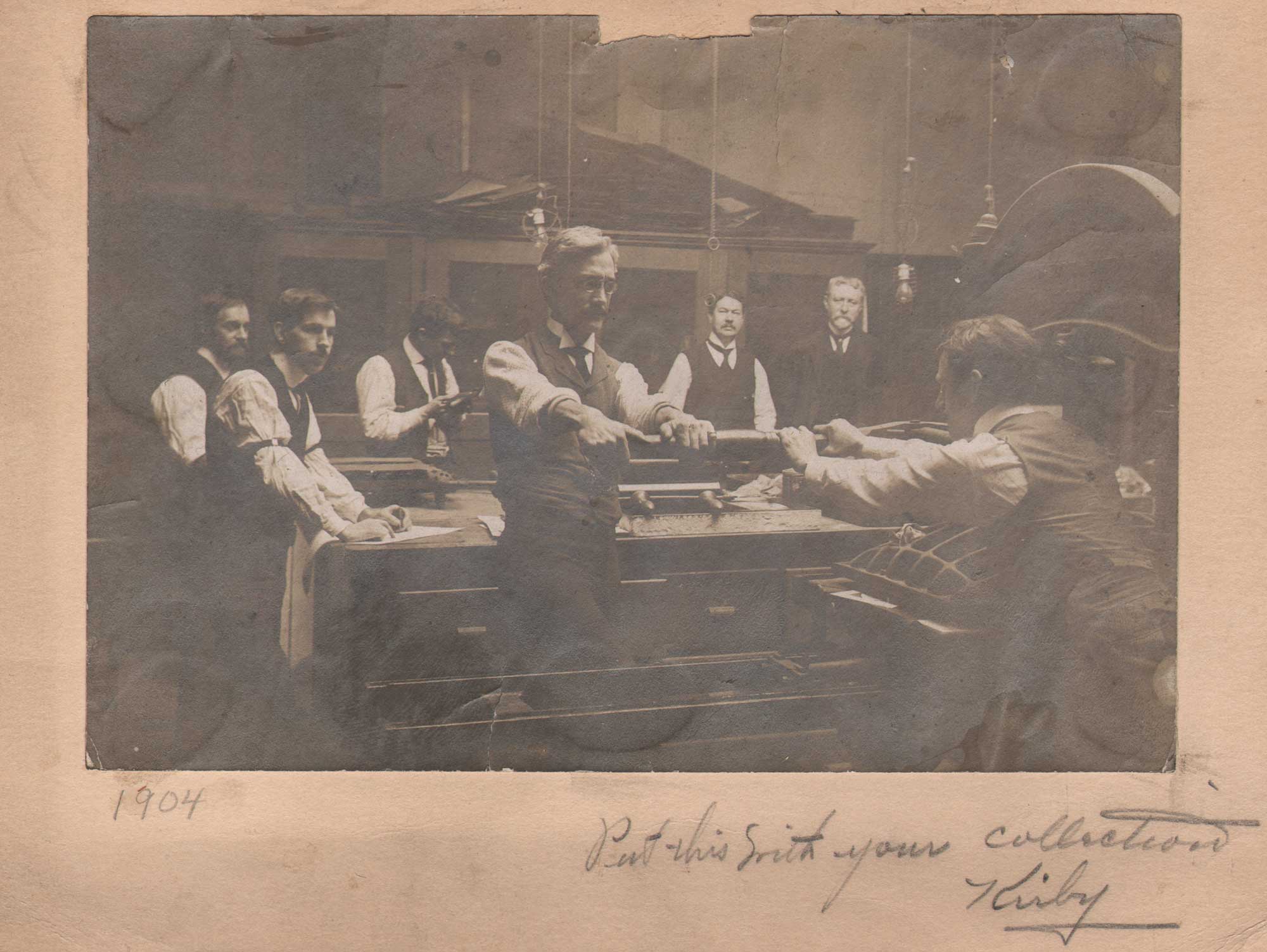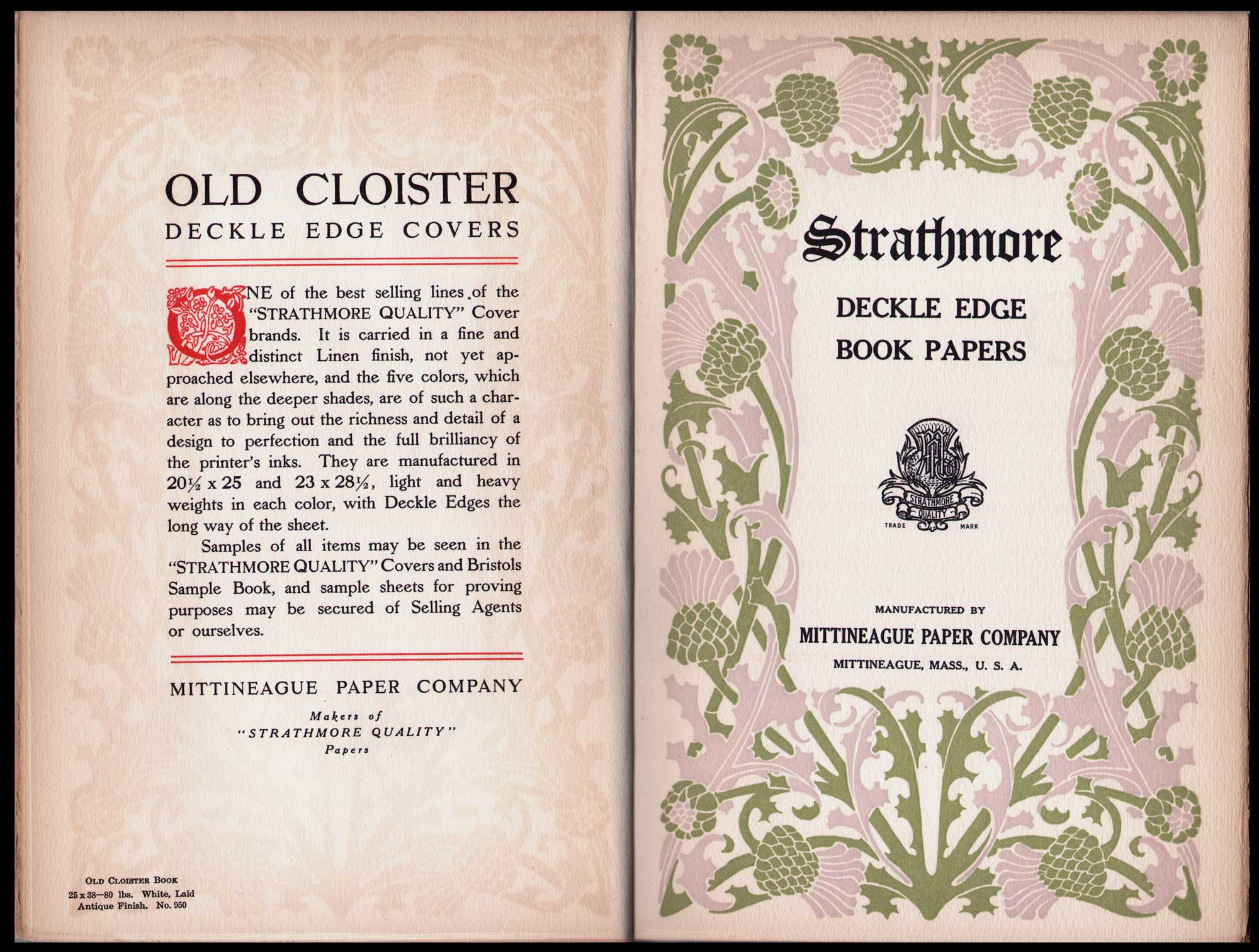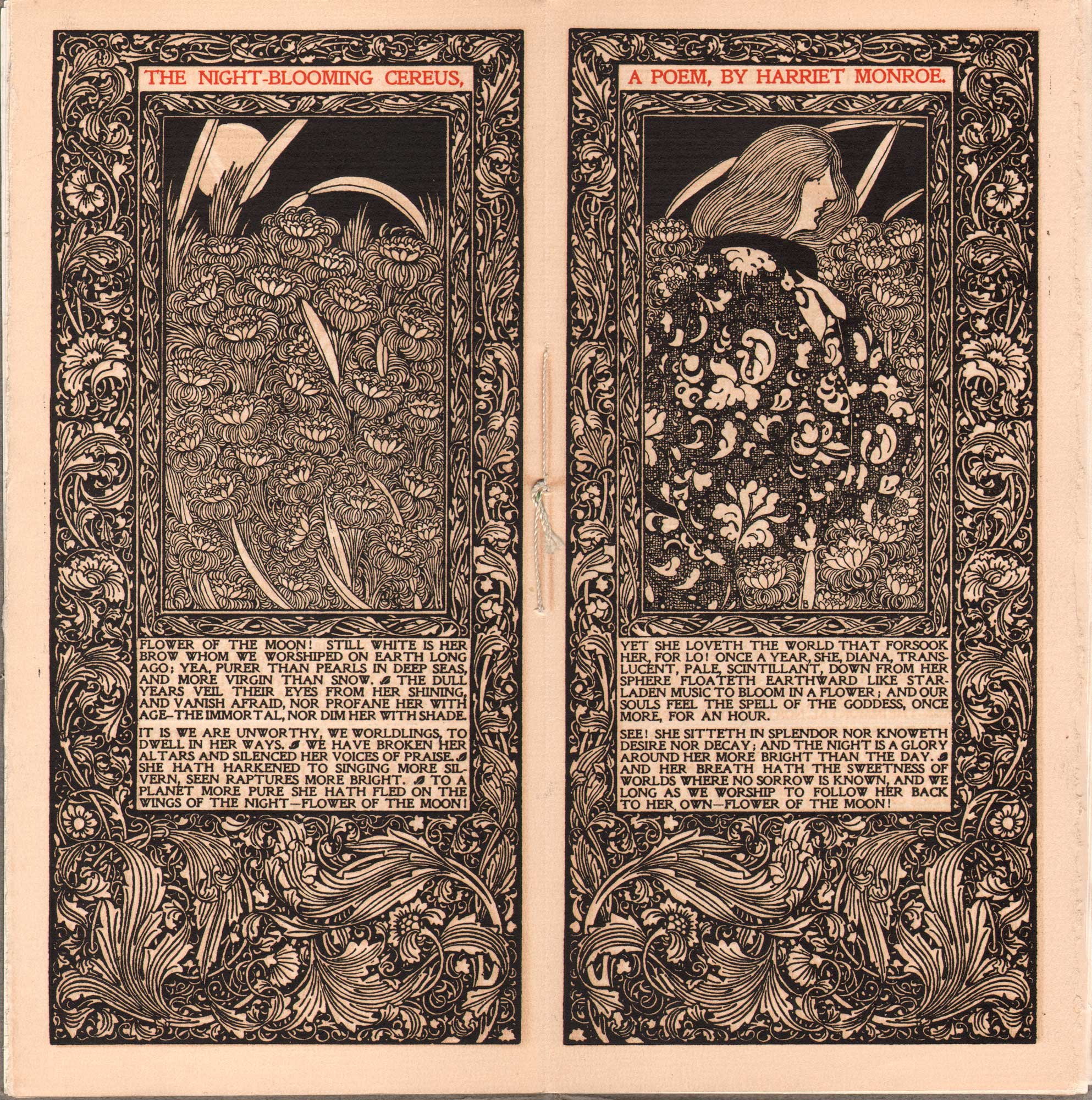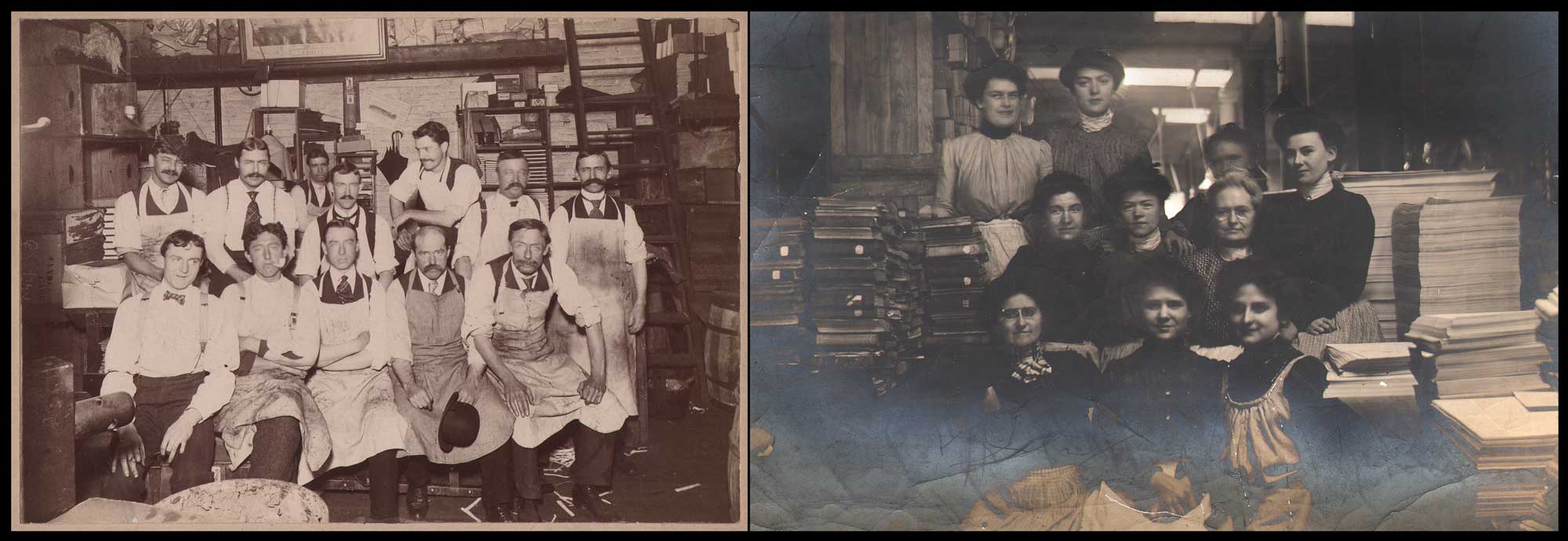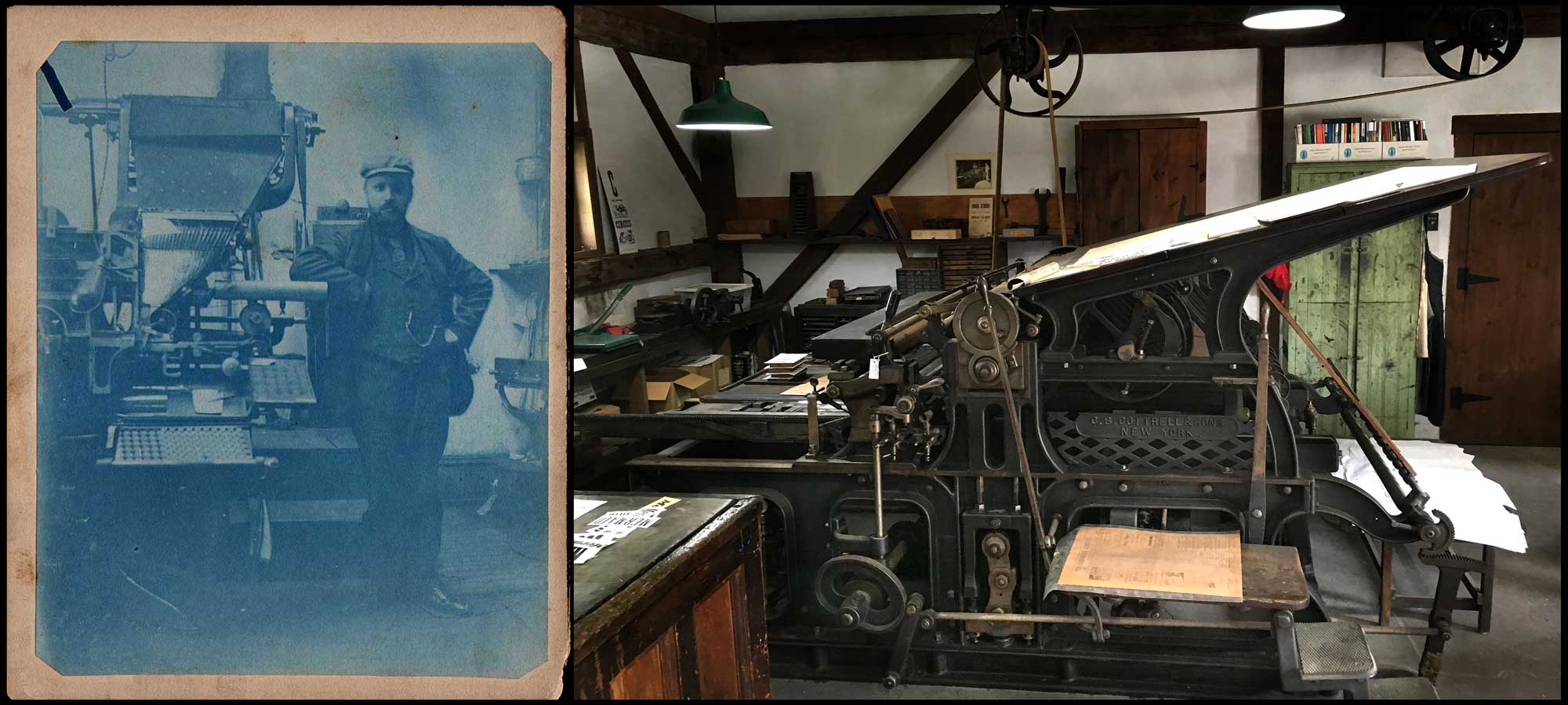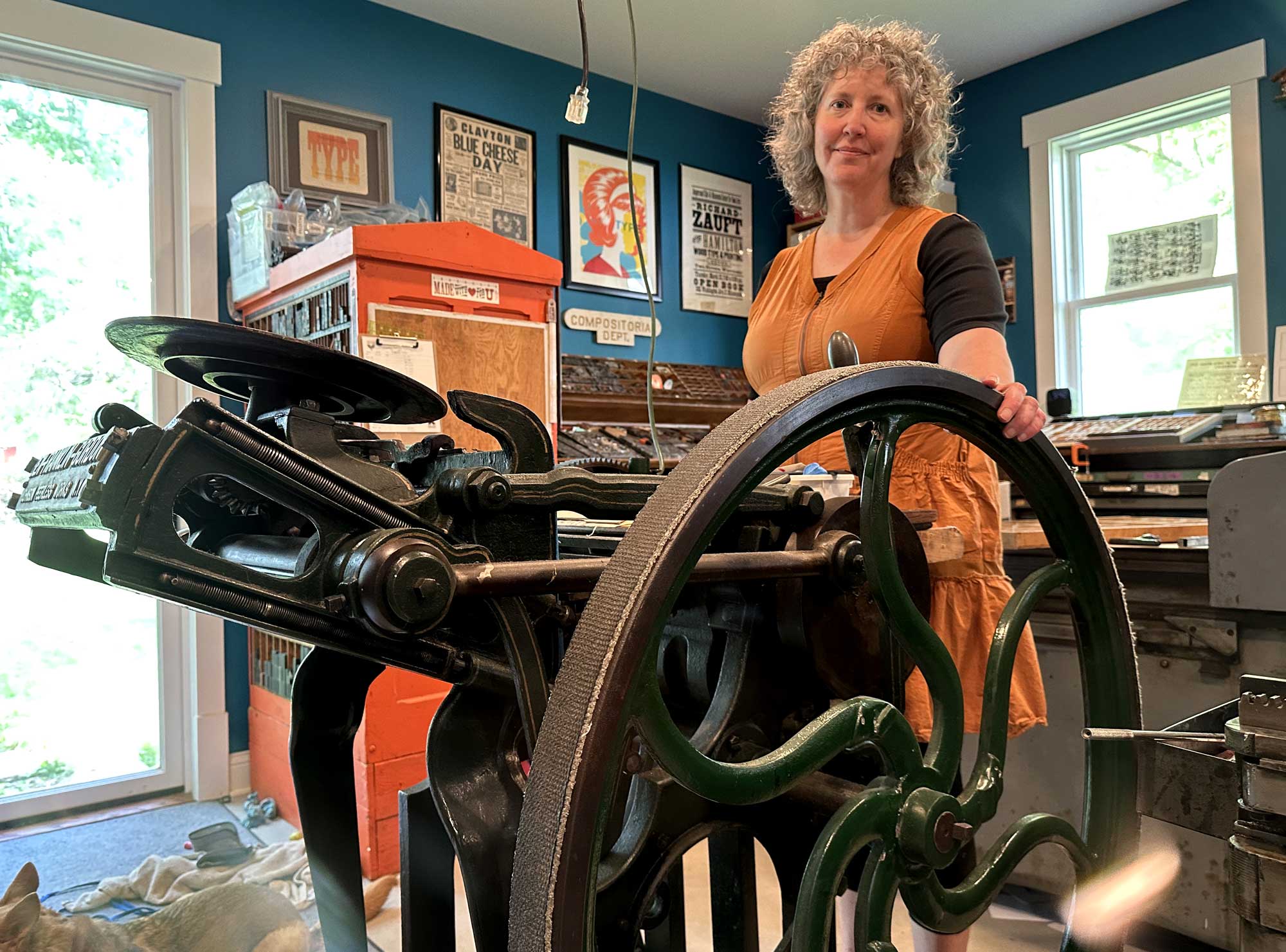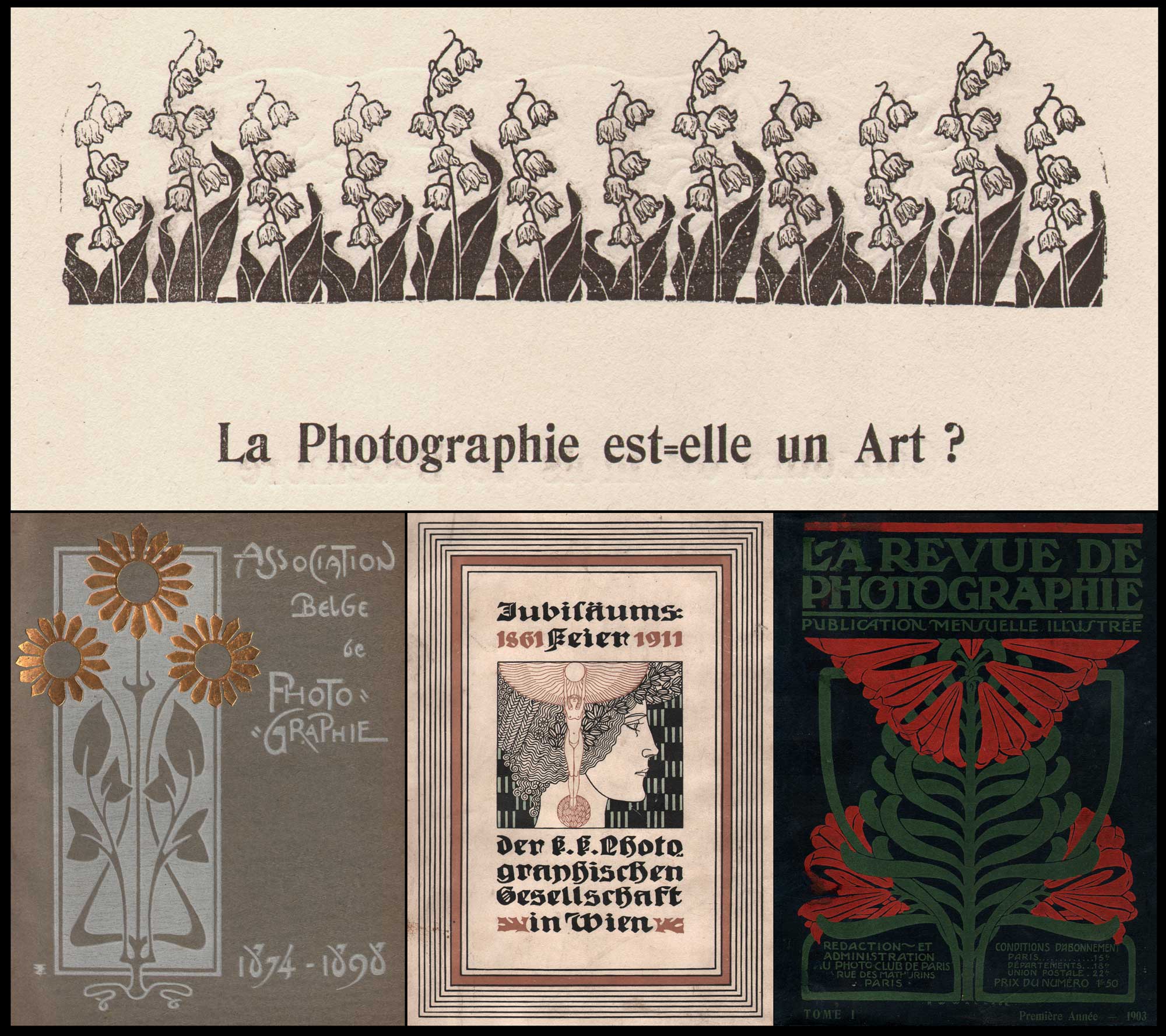
The Allen sisters of Deerfield: Frances Stebbins Allen at left, c. 1906 & Mary Electa Allen at right, c. 1913, (platinum prints) both: Courtesy Memorial Hall Museum, Pocumtuck Valley Memorial Association, Deerfield, MA. Center: “Deerfield Street: Childs House”, c. 1900-1905, Frances & Mary Allen, American, 1854-1941 & 1858-1941, platinum print, unmounted, 15.1 x 20.3 cm. Huge elm trees, now lost, provide the canopy for Old Main st., known as “The Street”, in Old Deerfield village, the photographers long-time home. From: PhotoSeed Archive
“Green meadows stretched in the sunlight, with the horizon of the gently curving hills; a quiet street overarched by mighty elms-the rows of stately trunks and the branches meeting overhead, like the pillars and arches of a cathedral aisle; a path below in green shadow, with splashes of yellow light, ⎯ this is old Deerfield.” ⎯ Mary E. Allen, 1892

Left: a Massachusetts Tercentenary Commission sign erected in 1930 along the Old Main street in historic Deerfield marks the towns rich history, including the 1704 Raid on Deerfield by French and Native American forces leading to 47 deaths. Right: Visitors scoot across Old Main Street in front of the First Church of Deerfield, built in 1824. Known locally as the “Brick Church”, the present Unitarian congregation was originally established as The Congregational Church of Deerfield, 1673. Both: 2025 photos by David Spencer for PhotoSeed Archive
Frances Stebbins Allen (1854-1941) and younger sister Mary Electa Allen (1858-1941), self taught photographers who worked in the Pictorialist aesthetic, succeeded professionally in their vocation and lived long and fruitful lives, are today’s subject. Never marrying, their sibling bond sustained them through all of life’s challenges and rewards, and they died within four days of each other. Like many of their ancestors going back to the 17th century, the sisters life-long home was in Western Massachusetts, in the village of Deerfield, a place marked by a rich history including the trauma shaping Colonial America. The PhotoSeed archive is fortunate to own a small number of their original photographs, and after collecting ten more examples earlier this year, I decided to dig a bit deeper into their lives.

“Hear the Frogs !” c. 1908, Frances & Mary Allen, American, 1854-1941 & 1858-1941, platinum print, unmounted, 15.6 x 20.1 cm. A little boy and girl stand holding hands while another sits overlooking the banks of the Deerfield River in the town. This work was shown in late 1908 along with 71 other photographs by the Allen sisters at The Art Institute of Chicago. From: PhotoSeed Archive
The “quiet street” described by Mary Allen in our opening quote, with the sisters photograph showing it at center, was the very street she and Frances lived on starting three years later in 1895. Her words evoke for the reader religious overtones: the imagery of a cathedral, an apt metaphor for the solidity of its “pillars and arches” being a stand-in for their historic New England town. In my mind, her description also extends to photography: these lines were the first for her article in the New England Magazine, which was illustrated by halftone photographs and line engravings also given credit to the author. The importance of light— “splashes of yellow light”—is another giveaway Mary Allen was already a keen observer of the medium’s innate etymological description of “drawing with light”. Ultimately, both the sisters’ lives would be shaped by forceful inner natures aided by Yankee grit, pluck and perseverance.
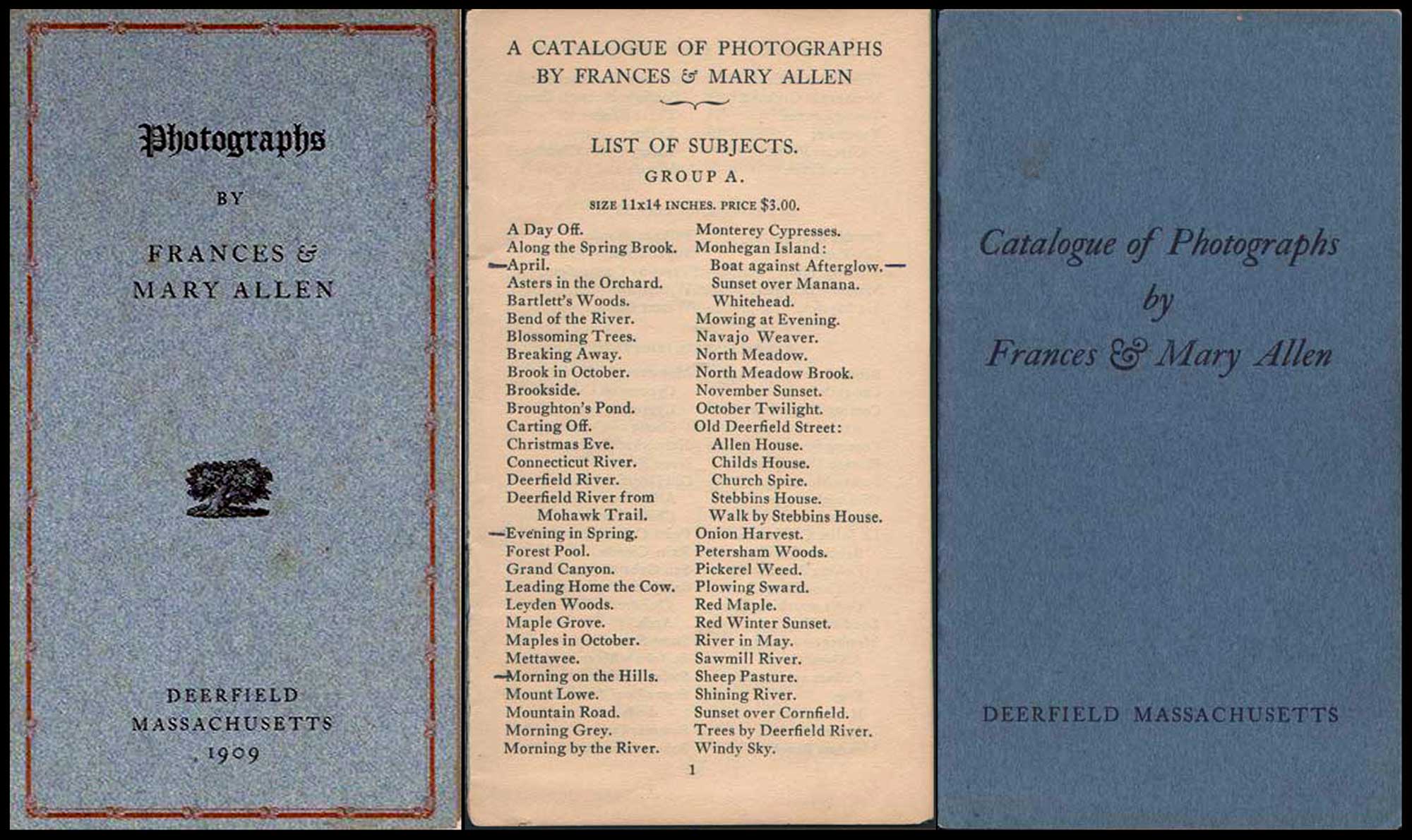
The Allen sisters issued seven catalogues listing their photographs for sale from 1904-20. Left: Catalogue cover: “Photographs by Frances & Mary Allen“, 1909. Credit: private collection. Middle & Right: opening page & cover: “Catalogue of Photographs by Frances & Mary Allen”, 1920, stapled, light blue paper covered wraps, 14.6 x 8.3 cm, 11 printed sides. Last catalogue issued. There are 556 photographs listed for sale in categories including Landscapes, Country Life, Children, Old Deerfield and others, with unmounted platinum prints in various sizes priced at .35¢ to $3.00 for the largest 11 x 14” print. Link to 1920 catalogue in collection. From: PhotoSeed Archive
Here’s a quote I came across defining the arc of their photographic accomplishments by Mel Allen, writing for Yankee Magazine in 2016:
“For three decades, from the end of the 19th century into the early 1920s, the photographs made by two sisters, Frances Stebbins Allen and Mary Electa Allen, bathed the people and landscape in and around their home in Deerfield, Massachusetts, in a painterly, elegiac glow.”

Photographic Sales & Exhibits: The Allen sisters marketed and sold photographs from a first floor parlor of their ancestral 18th Century saltbox in Deerfield from c. 1900 until 1935. Top: Allen house postcard around 1905: part of online presentation for Deerfield Arts & Crafts: In the Springfield Republican newspaper, a visitor impression from 1919: “We cross the road to enter the gray old house of the Misses Allen who make photographs. And there in a front room of the house are pictures enough to charm you as long as you can spare the time to look at them. The photographs are the finished work of artists in their handling of light and shadow and the accentuating of detail. The subjects are many.” Screen grab: Courtesy Memorial Hall Museum, Pocumtuck Valley Memorial Association, Deerfield, MA. Middle: Today, the former sales room in the Allen House has been converted back to a 18th century bedroom. The home can be visited as part of the Historic Deerfield experience. Photo: October, 2025 by David Spencer for PhotoSeed Archive. Bottom: The Village Room was the first Deerfield Arts & Crafts exhibition space. A detail from an 1899 photograph by the Allens shows various crafts and wares on display, including framed photographs on the walls by the sisters and Emma Coleman. Courtesy Memorial Hall Museum, Pocumtuck Valley Memorial Association, Deerfield, MA.
And this, from 1905, contrasting their efforts with painting:
“Another author argued that, ‘the work of Miss Frances Allen and Miss Mary Allen…would be equally at home in this room or next door to the small gallery of paintings which Mr. Tack has hung in his studio. The Misses Allen use their camera in the same spirit with which a painter uses his brush, and their sense of composition, of the dramatic moment, is as eminent a qualification for their work as for his.’”(1.)

Top: “Allen House, Side View”, c. 1910?, gelatin silver rppc, AZO stamp box, c. 1918-30, Charles H. Howard, American, 8.7 x 13.8 cm, #41 from series: “Photographic Post Cards of Old Deerfield, Mass., sold by Mary Wells Childs of Deerfield, published by Charles H. Howard, Northampton, Mass.” The woman standing at right is believed to be one of the Allen sisters. Before marketing postcards, Childs made bayberry candles in 1908 and sold rag rugs in 1912 as part of the Society of Deerfield Industries. Historic Buildings of Massachusetts states the Allen House dates to 1734, and “ the land was originally owned by Simon and Hannah Beaman, who had been captured during the raid. The house was occupied by the Bardwell family and then by the Allen family, after the 1842 marriage of Catherine Elizabeth Bardwell and Caleb Allen. In 1896, Caleb Bardwell’s nieces, Frances and Mary Allen, with their mother took possession of the house.” From: PhotoSeed Archive. Bottom: left & right: Two modern views of the home taken in June, 2025: side view and frontal view. Photos by David Spencer for PhotoSeed Archive
I agree with both assessments summing up their talents, but there is so much more the Allen sisters can teach us in the second decade of the 21st century. One attribute: determination. Although it was not cited often, other than brief mentions in secondary sources, (as surely the sisters would have wanted it) their deafness, in my opinion, actually enabled them in their art. After the onset of deafness in the mid 1880s—a shocking change that led to both abandoning brief teaching careers around 1884–a new career path of professional photography took hold in 1888.
The idea that one of the human senses disrupted in life could also be perceived as an advantage lends itself to a working theory of why the sisters’ work endures to the present. At the outset of pictorial photography, in the 1890s, rules for the artistic sensibilities of the medium were still being figured out. It’s well understood that the loss of one of the five basic human senses of sight, hearing, smell, taste and touch can strengthen the remaining senses. I even looked it up: Neuroplasticity is the scientific name for when those affected areas of the brain are repurposed to enhance a person’s other senses. A possibility perhaps for the Allens but one which might give a clue to their determination and flexibility enabling a profound body of historical photography that still matters today.

The Allen House: Rear Views: Top Left: “Winter Moonlight”, c. 1906, Frances & Mary Allen, American, 1854-1941 & 1858-1941, platinum print, unmounted, 20.8 x 15.6 cm. An unusual night-time view of the photographers home. Notice the footprints in snow at foreground. Before altered with a central chimney by Henry Flynt in 1945, the home was subdivided into two living quarters: notice the separate chimneys and lack of dormer windows compared to the modern-day view at right, taken June, 2025. A single dormer window appears in another Allen sisters photo at UMass Amherst dated c. 1913. From: PhotoSeed Archive. Right: David Spencer for PhotoSeed Archive. Bottom: “Back of Allen house, Deerfield”, c. 1913, gelatin silver rppc, September 13, 1916 postal cancellation, Frances & Mary Allen, American, 1854-1941 & 1858-1941, 8.6 x 13.8 cm. From the 2002 volume “The Allen Sisters Pictorial Photographers 1885-1920”: “The vine-covered porch at the far end of the ell, known as the “Cabin,” was the location for many portrait and figure studies. In 1903, the Allens added a new developing room to their home on the second floor above the shed.”( p. 29) From: PhotoSeed Archive
This line of thinking could lead to a reasoning where the Allen sisters enabled vision comes into play. The adage of “trusting your eye” is perhaps the best advice anyone can give a collector considering an artist’s work. In my mind, their photographs elicit a humanity and beautiful sense of place setting it apart from most of their contemporaries. Just look at the joy of humanity in some of their select works, as well as some of their chiaroscuro landscapes shown in this post. On a basic level, they perfected the craft of photography in a silent world. But this disability most assuredly did not prevent their great success. After coming to the attention of American photographer Frances Benjamin Johnston in the mid 1890s, the sisters were soon earning many steady assignments from national magazines such as Good Housekeeping and others- particularly for their endearing studies of children posed in and around their Old Deerfield neighborhood.

The Street for Arts & Crafts: Left: “The Street: Joseph Stebbins House: Deerfield, MA”, c. 1900, Frances & Mary Allen, American, 1854-1941 & 1858-1941, unmounted gelatin silver print, 15.4 x 20.5 cm. From: PhotoSeed Archive. Right: Displayed as part of the exhibition “Skilled Hands and High Ideals” at Memorial Hall Museum, this 1911 facsimile copy of the Deerfield Industries street map shows open shops for member artisans. Show copy: “These local women became part of an international Arts and Crafts Movement, celebrating the beauty and virtue of handmade items and revitalizing fast-disappearing craft skills. Beginning with the Deerfield Society of Blue and White Needlework in 1896, Deerfield crafts would soon include basketweaving, metalworking, pottery, furniture making, and more. In the process, Deerfield women transformed an economically depressed agricultural town into a vibrant cultural and tourist center, highlighting its colonial history and selling Deerfield-made crafts across the United States.” Copy photo by David Spencer for PhotoSeed Archive
When I was a young and earnest photojournalist, my guiding philosophy was always to blend into the background and look for “found moments” with my camera. I can still hear myself introducing myself to a subject and telling them to “pretend I’m not here” as I drifted into the background, somehow trying to convince them and myself of a magical ability to disappear. But the working reality over 125 years ago for the Allen sisters was that film emulsions and lenses were not fast enough to capture spur of the moment and fleeting human interactions. Their use of a tripod-mounted view camera and all of the attendant equipment needed on location created a much different reality in approaching an assignment or chasing the waning light of a late fall afternoon. Here’s a quote by the sisters published in 1894 in the pages of The Photo-Beacon, summarizing a few of their working methods. It’s a passage showing their practical nature and endearing me to their hands-off approach:
“The merit of posing, which you kindly give us credit for, belongs rather to the models. Our chief virtue is in letting them alone. We usually have better success with children who are not too highly civilized, or too conventionally clothed, or who are too young to be conscious. We give them a general idea of the picture we want, and then let them alone until they forget about us and the drop catches an unconscious pose. They consider it a game, and are always ready to play at it.” (2.)

Embroidery as Art: Left: “Rose Standards, top row & Other Designs”, c. 1900 -1916. The gloved hand of Memorial Hall Museum Curator and Assistant Director Ray Radigan holds one of the thousands of original glass plate negatives taken by the Allen sisters, with this plate showing embroidered designs on cloth. Mary Allen was heavily involved in the Deerfield Society of Blue and White Needlework when founded in 1896. She was also treasurer of the Society of Deerfield Industries “for most of the years between 1901 and 1919”. Right: Detail: “The Unicorn”, c. 1920, Margaret C. Whiting, American, 1860-1946, appliquéd and embroidered panel , H. 55″ x W. 28”, Museum online resource copy: “A lone unicorn springs across a secluded glen in what is believed to be the final work of Deerfield Society of Blue and White Needlework co-founder, Margaret Whiting. Protected and framed by stately pine trees in the fore- and backgrounds, the illumined clearing is further defined by a series of overlapping hills appliquéd in varying shades of green linen. The needlework’s stylized and carefully arranged woodland motifs foster the sense of emanating quiet.” In 1896, Whiting and Ellen Miller co-founded the Deerfield Society of Blue and White Needlework. Both: Photos taken June, 2025 by David Spencer for PhotoSeed Archive
In 1901, Johnston promoted the Allens work in the pages of the Ladies’ Home Journal as part of the recurring feature: “The Foremost Women Photographers in America.” Vignette portraits of the sisters anchored a full page, featuring five of their better known photographs in the July issue. Before their commercial career wound down by 1920, (they continued to sell photographs from their home until 1935) they had made a good living and become well known in Deerfield and regionally for their camera artistry. By late 1918, “an Allen niece told a neighbor that ‘the aunts have eleven National magazines using their pictures this month.’” (3.)

Making a name for themselves with national exposure in the popular press: Left: The December, 1900 cover of Good Housekeeping was the first time the magazine had used a photograph for a cover illustration. The subject was the photographer’s nephew, Frank Allen, looking for goodies inside his Christmas stocking taken the year before. Right: In the recurring magazine feature: “The Foremost Women Photographers in America”, a full page of the Allens photographs along with their vignette portraits appeared in the July, 1901 issue of the Ladies’ Home Journal. The feature had been made possible by American photographer Frances Benjamin Johnston, who began to promote the sisters work beginning in the mid 1890s. Both: online screen grabs: private collection & The University of Michigan.
Essential Monograph & Founding of Historic Deerfield
A lovely volume, The Allen Sisters Pictorial Photographers 1885-1920 (Pocumtuck Valley Memorial Association/University Press of New England, 2002) was the proverbial ball that got things rolling for me in looking closer at the Allen Sisters. This monograph, deeply researched, beautifully designed, and published for a traveling exhibition of their work, was organized and written by Suzanne L. Flynt, then curator of the Pocumtuck Valley Memorial Association.
In a neat occurrence, I learned the author’s husband is the grandson of Historic Deerfield founders Henry and Helen Flynt. After the Allen sisters died, the couple purchased the sisters former home on “The Street,” converting it back to its earlier 18th century architectural origins for their summer home. Unfortunately, other than being known today as The Allen House, nothing remains of the sisters’ life in the home’s interior, other than a general footprint of its late 19th and early 20th century walls. Exterior views, front and back, are unchanged, other than a reconfiguration of a center hall chimney, and I’ve included several historical photographs of the home along with this post, matching them with modern views. Fortunately, the home is occasionally open for tours as part of the larger Old Deerfield visitor experience, which this writer took advantage of. When the Allens lived there, it served as home base for an exhibition space on the first floor, a darkroom in the cellar and studio space with skylight on the back addition. Sixty years after the sisters’ passing, Suzanne Flynt’s monograph would revive national interest in their photography, giving them much deserved acclaim for their work.
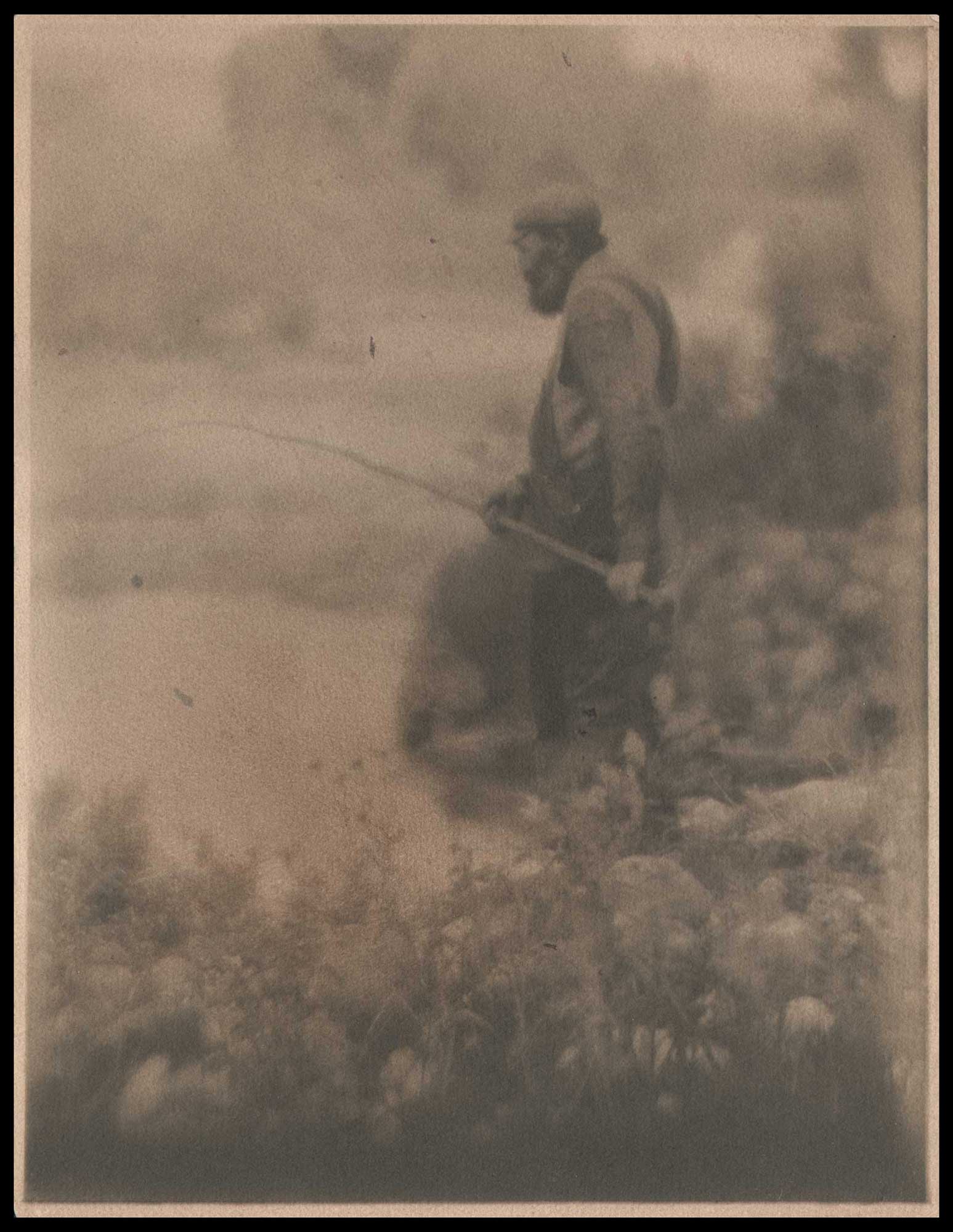
“A Day Off”, 1913, Frances & Mary Allen, American, 1854-1941 & 1858-1941, unmounted platinum print, 20.8 x 15.8 | 21.5 x 16.5 cm. In 1913, after a successful session photographing farmhand Dennis Burnett at Mill River (pl. 83), Mary wrote, “I’d rather do country folk at work than anything else in the world. Nothing is more difficult – than to get them in good poses – and unconscious. Dennis B- is a treasure… He has an interesting head – a good bent figure – and is very simple and well bred in manner”. Believed to have been printed around 1920, the orientation of this work has been reversed, compared to plate #83 published in the 2002 volume The Allen Sisters Pictorial Photographers 1885-1920. From: PhotoSeed Archive
Henry Flynt, who was born in Brooklyn and became a lawyer, and his wife incorporated Historic Deerfield in 1952 in the image of Virginia’s Colonial Williamsburg, another living history museum in the US. The Deerfield project, which took form in the late 1930s, was spurred on by their love and preservation of American history when their son in 1936 first attended Deerfield Academy in the town. Unlike Williamsburg, their vision was based on the much earlier English settlement of Deerfield, MA, a town incorporated in 1673. The couple’s passion project led to the town establishing the Old Deerfield Historic District in 1960, and today Historic Deerfield continues to be a vibrant destination and teaching laboratory for early American architecture as well as a showcase for important collections of historical objects, antiques and artwork, some by the Allen sisters. On Henry Flynt’s passing in 1970, the New York Times lauded his vision in part of an editorial:

Approximately 8500 vintage photographs & original glass plate negatives representing 2500 unique images by the Allen sisters are held at Deerfield’s Memorial Hall Museum. Ray Radigan, Curator & Assistant Director, shows off a platinum print: the sisters photograph “Blowing the Fire”, featuring a young Frank Allen using a bellows fireside. Photographed June, 2025 by David Spencer for PhotoSeed Archive
“Those who preserve or restore an admirable achievement of the past also serve the future. That is because civilized men and women want to know and understand their own origins. It is not only a deep human impulse but also a sensible recognition of the fact that each generation builds on the accomplishments of all those who have gone before. There is no instant civilization and no way to manufacture a people’s heritage.
In an age of vulgar publicity and hectic impatience for results, it is worth remembering a man like Henry Flynt who took the trouble to rescue what was beautiful and enduring from an earlier age of anger, turmoil and danger.” (4.)

A permanent exhibit featuring several Kodak cameras and view camera lenses used by the Allen sisters is displayed at Memorial Hall Museum. At center is a copy of a c. 1886 photograph of Mary Allen preparing to take an exposure using a view camera, photographed by sister Frances. Among the equipment is a Bausch and Lomb Optical Company lens from around c. 1890 at upper left and Eastman Kodak No 3-A Folding Pocket Camera, Model B-4, at upper right. Some of the museum’s display copy: “As pioneers in the young art of photography, Frances and Mary Allen were famed for their work in the region. They originally shared a single camera, but eventually had at least four between them. Several of their cameras and lenses were manufactured in Rochester, NY, while others came from Boston, and as far away as Paris.” Photograph from June, 2025 by David Spencer for PhotoSeed Archive
Old Deerfield: The Past & Raid
I visited Historic Deerfield several times this year, the first in June after reading the 2024 book The Deerfield Massacre, by James L. Swanson, who sadly passed earlier this year. (5.) I wanted to see and think about the bigger picture of the town’s history as I walked down its leafy main street. The volume is required reading for those wishing to learn more about the background and aftermath of what led to the surprise 1704 attack on Deerfield by French and Native American forces during Queen Anne’s War that killed 47 colonists.
The Allen sisters, by blood, were connected to the tragedy. Mary Allen, writing in 1892, shared her childhood impressions:
“The first tales of adventure which we who are Deerfield children heard were the stories our grandfathers lived. I remember lying on the floor, before the open Franklin stove, and reading by the firelight a worn copy of Hoyt’s ‘Antiquarian Researches.’ The book opened of its own accord to the account of the slaying of my own great-great-grandfather by the Indians. The touch of the bloody tomahawk conferred knighthood and renown on its victim. The honors which I tried to bear with modesty are borne by many Deerfield children.” (6.)

On Display & in Storage: At Memorial Hall Museum, a yearly, revolving gallery of images are displayed on a specific theme. The current show is called: Allen Sisters on “The Street.” Left: From around c. 1900, the framed photograph “Calls in Cranford”, an homage to English author Elizabeth Gaskell’s novel Cranford, shows a woman in period clothing walking down steps to a home on the Street. Top: An original 18th century “skeleton suit” made of calico printed cotton c. 1792 is framed along with the 1897 Allen sisters photograph “An Old-Fashioned Boy”, showing Carl Allen wearing the suit seated on a chair. Bottom: In storage, museum curator Ray Radigan adjusts the fingers of Frances Allen’s “alphabet glove” (a reproduction) used to aid her deafness beginning in the early 1930s. The museum occasionally uses the glove as a teaching aid in telling the Allen sisters story. Photographs from June, 2025 by David Spencer for PhotoSeed Archive
Also known as the Raid on Deerfield, 112 town residents were taken captive and forced to march in the winter snow to Montreal, 300 miles distant. As is true for all of what eventually became known as the United States, the lands in and around what became the future Deerfield were inhabited by native peoples. The indigenous Pocumtuck nation had long settled this area, with the town later “originally established as a grant of land to the residents of Dedham, Massachusetts, who had given land to the Massachusetts Bay Colony for the purpose of settling Christianized Indians.”(7.) It’s hard to believe today, but this area in western Massachusetts was once on the western frontier of English settlement, long before the boundaries of the American continent could even be delineated or a Declaration of Independence written on parchment.

Record of a Brief Life, by Pen & Camera: Correspondence by the Allens, including letters and at least four diaries by Mary Allen, are held in the Pocumtuck Valley Memorial Association Library. Left: Detail from diary entry by Mary Allen on October 5, 1913: “Mrs. Thayer came in late to tell us that little Roana Andrews died this afternoon, of Cholera Infantum. She was running around out of doors- barefoot and scantily clad yesterday and ate watermelon. She has been ailing for a few days and her mother had not considered her sick – until she found her unconscious this morn (?) and sent for the doctor. She was dying-only lived a few hours – It was a great shock to everybody, – the little things ran around like the herd of ducks, with little more attention – Vera said she moaned and called for water the night before but no one paid much attention; Poor little (?) ! She was a (cunning – curious?) thing. Frances has been taking pictures of her lately, over and over- She had more flavor in her looks (?) than most of them.” Roana W. Andrews: 1911-1913. Photograph of diary page by David Spencer for PhotoSeed Archive, courtesy PVMA Library. Right: “Roana Sweeping”, 1913, Frances & Mary Allen, American, 1854-1941 & 1858-1941, mounted platinum print. Frances Allen photographed 2 1/2 year old Roana Andrews only days before her death. Roana is caught in the moment of sweeping stepping stones using a small broom. Photograph Courtesy Pocumtuck Valley Memorial Association’s Memorial Hall Museum, Deerfield, MA
Complicated is an understatement, and generational family members tracing their lineage to the 1704 raid and earlier still live in this upper Connecticut River Valley area. A most unusual relic from the raid, that of the battle-axe scarred front door from the former Ensign John Sheldon house survives. The home was razed in 1848, with a replica of the so-called “Old Indian House” erected in 1929 on a different parcel along the main street. American history pilgrims can view the door, part of a little known event shaping the country’s founding, on the second floor of Memorial Hall Museum in Old Deerfield. One interesting bit: Deerfield residents had actually tried saving the Sheldon house from destruction, their efforts of cultural preservation coalescing in 1870 with the founding of the Pocumtuck Valley Memorial Association. Today, PVMA, as part of its mission statement, “purposely chooses to remember and honor the Pocumtuck People and their homeland with the organization’s legal name. PVMA today recognizes the damage inflicted by colonial settlement and seeks to go further by interpreting these difficult histories from culturally diverse, nuanced, and inclusive perspectives.”

The Raid on Deerfield: The Deerfield story was shaped by a surprise 1704 attack by French and Native American forces during Queen Anne’s War that killed 47 colonists in the English village. Left: “Old Sheldon House Door”, this battle-axe scarred front door from the former Ensign John Sheldon house is the centerpiece exhibit at Memorial Hall Museum in Old Deerfield. Top Right: “John Sheldon House 1848”, George Washington Mark, American, 1795-1879. Displayed in the museum is this oil painting of the former home executed the same year it was razed. Mark was a Greenfield, MA folk artist and house painter. Middle Right: In 1929, a replica of the so-called “Old Indian House” was built on a different parcel along the main street in Deerfield. It’s known today as the Indian House Children’s Museum. All: photographed June, 2025 by David Spencer for PhotoSeed Archive. Bottom Right: Infamous, due to the Raid on Deerfield, countless artistic depictions of the Sheldon home survive, including this likely juvenile or folk art depiction by an unknown hand c. 1850-1900. The work descends from the estate of Samuel Burbank Williams, 1843-1927, whose Deerfield lineage descends to Ephraim Williams, 1691-1754, whose son Ephraim Williams Jr. was the founder of Williams College. From: PhotoSeed Archive
A collaborative effort with Historic Deerfield who manage these resources as “Memorial Libraries,”the PVMA operates the Memorial Hall Museum and its library: one of the oldest American history museums in the US and repository for over 8500 Allen sisters photographs & original glass plate negatives representing 2500 unique images.

Changing Homes of the Street: Top: “Deerfield Street: Childs House”, c. 1901-1910, unknown American photographer, (possibly Allen sisters who were known to produce cyanotypes of Deerfield), masked cyanotype printed on rppc, 5.7 x 10.0 | 8.7 x 13.8 cm. Dating to around c. 1798, this home was built by David Sheldon (1770-1841) and came to be known later as the “Pink House”: photographer Emma Coleman in her 1907 guidebook calling it “the ‘pink house’ (which was red long ago)”. At the turn of the 20th century, the house was known as the Childs House, named for owners Samuel Childs IV: 1843-1906, and his wife, Mary Ann Vincent Childs: 1854-1938. Memorial Hall Museum Curator & Assistant Director Ray Radigan commented on this photo: “As for dating the photo, the telephone pole and a barely visible trolley track indicate that the photo was taken no earlier than 1901 when the electric trolley was installed in Deerfield.” From: PhotoSeed Archive. Bottom: The home in the present day. Located at 92 Old Main Street in Deerfield, its been owned by the trustees of Deerfield Academy since 1977. Photographed October, 2025 by David Spencer for PhotoSeed Archive
Old Deerfield: The Present
Today, a stroll down “The Street” is a rare occurrence in modern-day America. I’m being a bit flip here of course but that’s because “progress” in this country inevitably involves heavy equipment erasing the past for a new shiny present. Not so in Old Deerfield. The majority of the homes on either side are later 18th and early 19th century in origin, with many of these Federal and later period homes accessible to tour via a Historic Deerfield day ticket. I’ve managed to pair up several “before” photographs taken by the Allens with similar vantage points in the present. Mary Allen’s view of the Manse, also known as the Willard house, as well as a photo credited to the sisters of the front door of the John Williams house, (named for Reverend John Williams, survivor of the 1704 raid) should give you a bit of the flavor of this truly old, at least for us, American town.

“Grandpa!”, c. 1912, Frances & Mary Allen, American, 1854-1941 & 1858-1941, unmounted platinum print, 20.8 x 15.9 | 21.5 x 16.4 cm. Taking a moment while leaning on his rake or walking stick, Deerfield resident Benjamin Zebina Stebbins (1827-1912) speaks with his quizzical granddaughter. From: PhotoSeed Archive
If you enjoy museums like I do, it can sometimes be a letdown when visiting one where hardly any photographs are exhibited. I frequently grumble to my wife when exiting nearly any art museum on our travels: “really wonderful, but why not a few photographs on the walls?” Sadly, that seems to be the norm. Not so at Memorial Hall Museum in Old Deerfield. The oldest museum in Western Massachusetts, here you will find vintage photographs by the sisters on permanent display. In the Suzanne L. Flynt Gallery, a hallway exhibition space, a yearly, revolving gallery of images are displayed on a specific theme. The current show is called: Allen Sisters on “The Street.” Some of the exhibit’s introductory wall text:
“It’s hard not to see Deerfield through the Allen sisters’ lens. Frances and Mary Allen used the village as a backdrop in thousands of photographs. These sentimental scenes of days gone by were a mix of truth and fiction. In many photographs they posed friends, family, and neighbors, often including colonial-era costumes and props from local attics. These images were instrumental in shaping Deerfield’s historical image, and contributed to a lasting legacy of its collective memory of its past.”

Changing Views on the Street: Top: A present-day view of Deerfield’s First Church at far left and the Manse at right, photographed in October, 2025. Old Main Street runs between the two. This Georgian mansion, also known as the Willard House, is used today as the residence for the Head of School of Deerfield Academy. David Spencer for PhotoSeed Archive. Bottom: “Willard House (Manse at Deerfield Academy)”, 1892 or before, Mary Electa Allen, American, 1858-1941, unmounted platinum print, 11.3 x 19.0 cm. Mary Allen photographed the Manse in 1892 or before, as a variant without the First Church (built 1824) appeared in the illustrated article Old Deerfield, written by her for the September, 1892 issue of The New England Magazine. Built in 1768 but incorporating an earlier structure from around 1694, the Georgian mansion (for mansion house) was purchased in 1811 by the Rev. Samuel Willard, the first Unitarian Minister in Western Massachusetts. From: PhotoSeed Archive.
The museum also features a permanent display case with two Kodak cameras used by the Allen sisters later in their career, along with some of their earlier view camera lenses and lens boards. But I’ve saved the best for last. I met with Ray Radigan, the museum’s Curator & Assistant Director, (8.) several times in preparation for this post. Ever patient and accommodating, Ray, donning white gloves as needed, gave me a peek inside the ultimate Allen sisters archive: a special storage area within the museum. This is where shelved acid-free boxes hold a treasure trove: thousands of carefully matted and loose vintage examples of the Allen sisters life work and equal number of their extant glass plate negatives.

A Deerfield Door, Revisited: Left: “Williams Door”, ca. 1895-1905, Frances & Mary Allen, American, 1854-1941 & 1858-1941, unmounted platinum print, 20.2 x 12.7 cm. Built 1760, this home is named after Rev. John Williams, (1664-1729) who wrote “The Redeemed Captive”, an account of captivity by the Mohawk in Canada after a forced march after the Deerfield Raid of 1704 during Queen Anne’s War. The door was built from old-growth, eastern white pine by joiner Samuel Partridge. From: PhotoSeed Archive. Right: “Williams Door in 2025”, a replacement door has been in place on the front of the Rev. John Williams House since 2001, fashioned from the Partridge original. The home is owned by Deerfield Academy, a private boarding school founded in 1797 whose school seal features the door. Photographed June, 2025 by David Spencer for PhotoSeed Archive

“Rev. John Williams House (1760)”, ca. 1900-10, Frances & Mary Allen, American, 1854-1941 & 1858-1941, gelatin silver rppc, (KRUXO?) 1910-20), 7.0 x 13.2 | 8.7 x 13.8 cm (verso: ALLEN, DEERFIELD, MASS, RIGHTS RESERVED) Built 1760, this home is named after Rev. John Williams, (1664-1729) who wrote “The Redeemed Captive”, an account of captivity by the Mohawk in Canada after a forced march after the Deerfield Raid of 1704 during Queen Anne’s War. The following from Historic Buildings of Massachusetts : “His new house replaced the one destroyed in the raid. The current Williams House was actually built in 1760 on the site of the 1707 house by Rev. John Williams’ son, Elijah Williams, who was a shopkeeper and tavern-owner. When the house was in danger of being torn down in 1877, Deerfield historian George Sheldon wrote a series of articles (collected in the book The Rev. John Williams House, published in 1918) that raised awareness of the home’s importance and helped save it from destruction. Today the house is used by Deerfield Academy as the Elijah Williams Dormitory.” From: PhotoSeed Archive

Uncovering Details: Left: “A Holbein Woman”, 1890, Frances & Mary Allen, American, 1854-1941 & 1858-1941, mounted gelatin silver print: 20.1 x 16.3 cm | 35.2 x 27.8 cm. With overmat of primary mount removed, this signature portrait of the artists mother, Mary Stebbins Allen, 1819-1903, reveals graphite framing marginalia: some inverted along lower margin by an unknown hand: “FS Allen and ME Allen; opposite margin: 1- 16 1/4 x 18 Gray Mat Board Frame”. The work was exhibited in an unknown salon during the mid to late 1890’s. Upper Right: Example of an Allen sisters black ink stamp on verso of vintage platinum print: .9 x 4.0 cm. Notice inclusion of partial fingerprint at upper right. Lower Right: Verso: “The Hall and Staircase at “The Manse”, 1900-1910, Frances & Mary Allen, American, 1854-1941 & 1858-1941, unmounted platinum print: 17.7 x 12.6 cm. Ownership history, various publication marginalia and stamps, including by the Allen sisters, nearly fills up the verso of this photograph. All: PhotoSeed Archive
One very good insight he shared was that even with their involvement as artisans affiliated with the Deerfield Society of Arts and Crafts (founded 1901) as well as their earlier engagement with the Deerfield Society of Blue and White Needlework, (founded 1896) their medium of photography was technically advanced for its time and very modern indeed, especially pictorialist art photography. In this respect, Ray made the argument the Allen sisters were pushing the limit in what could then be achieved by photography. This was in contrast to the confluence of a new found interest in the Colonial revival and regional arts and crafts activity then taking place in Old Deerfield, defined by Ray’s employer, the PVMA , as “a movement that encouraged a return to hand craftsmanship, simplicity of design, and honesty of materials.”

Marketing Venture: Left: “Girl Holding Apple”, c. 1978-81 print from c. 1900-10 negative, Frances & Mary Allen, American, 1854-1941 & 1858-1941, gelatin silver print, 21.9 x 16.5 | 25.1 x 20.2 cm. (work may be known as “For Teacher” in AS catalogue) Between 1978-81, the Pocumtuck Valley Memorial Association marketed the Allen sisters work through Gates & Tripp, a Boston gallery located in Faneuil Hall marketplace. Archivally printed and priced at $20.00 per print, photographs were contact printed from their original glass plate negatives or internegatives made by Sal Lopes of the Olmo Studio, Newport, Rhode Island & presented within 12 x 15” white rag mats. A three-year contract between PVMA and the gallery was signed in May, 1978 with the stipulation 7% of the sale price of each print was paid back as a royalty. Library records from PVMA library show that from November 16 – December 31, 1978, the gallery sold 67 prints from plate size (8 x10”), an additional 13 larger prints sold matted to 16×20”, and six platinum prints (from an edition limited to 100 prints) sold at $60.00. PVMA loaned 124 negatives as part of the contract, with $141.75 paid as royalties the first year. Interestingly, the 1978 G&T promotional brochure “A New England Vision 1880-1930”, featuring platinum prints by the Allens and Martha Hale Harvey misspelled Mary Allens name as “Mary Electra Allen”, something that continues today. From: PhotoSeed Archive. Right: ca. 1978 “Gates & Tripp Historical Photography” promotional brochure opened to Allen sisters spread. “Girl Holding Apple”, stock #AS 21, reproduced at upper right corner. Photo of spread taken October, 2025 by David Spencer for PhotoSeed Archive, courtesy PVMA Library.
The Allen sisters may have worked in a silent world but left unsaid is the daily influence of the larger community of Deerfield family and neighbors they worked and lived with. Combined with their super power of astute observation and the reality of their deafness, these became guiding forces that enabled a defining vision for Frances and Mary Allen producing a body of work still relevant and beautiful today.

“Dorothy”, 1909, Frances & Mary Allen, American, 1854-1941 & 1858-1941, unmounted platinum print, 20.6 x 15.5 | 21.2 x 16.2 cm. Most likely taken in late 1909 based on the child’s age, Deerfield resident Dorothy Andrews (Dorothy Bennett Andrews Parmeter: 1908-2005.) is photographed looking away from the camera while instructed by the Allen sisters to cradle her head. Delicate profile views like this of a neighborhood child places the Allens in rarefied company: select practitioners of early 20th century artistic pictorial photography. From: PhotoSeed Archive
This is the first of a two-part post on the Allen sisters of Deerfield Massachusetts. The second will focus on their involvement with the Deerfield town pageants of the early 20th Century promoting the town’s rich history.
Notes:
- “Exhibition of the Arts and Crafts in the Martha Pratt Memorial” History and Proceedings of the Pocumtuck Valley Memorial Association, 1899-1904, Vol. IV, (MA: Deerfield), 1905, 277.
- Excerpt quote: The Allen Sisters pictorial Photographers 1885-1920, Pocumtuck Valley Memorial Association/University Press of New England, 2002, p. 27.
- Ibid, p. 44.
- Excerpt: Flynt of Deerfield, The New York Times, August 15, 1970.
- James L. Swanson was also an American historian and author of the 2006 book Manhunt: The 12-Day Chase for Lincoln’s Killer. (released as a miniseries produced for Apple TV+ in 2024).
- Excerpt, Old Deerfield, Mary E. Allen, New England Magazine: An Illustrated Monthly, September, 1892, p. 34.
- Historic Deerfield, Wikipedia accessed 2025
- In his spare time, Ray is an accomplished children’s book illustrator.






























